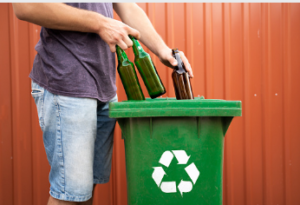Thorntons-Recycling bottle recycling depot are staffed facilities found in places with active deposit return systems where empty containers can be returned for their deposit refund. Retail stores typically operate them.
Retailers should clearly differentiate their can and bottle recycling bins from their trash bins through colour, signage and specialised openings. It will reduce the need for customers to think about what goes where.
Deposit Return System
Deposit return systems (DRS) provide a financial incentive to drink container manufacturers to include recycled content in their products. They do so by adding a small deposit to the cost of drinks, which is refunded when consumers return the containers for recycling. They have proven to be effective at reducing beverage container litter, typically reducing it by 30-84%, depending on the size of the deposit.
Retailers accept the bottles and cans under a DRS by either automatically using reverse vending machines or by placing collection bags in-store. The bottles and cans are then collected, processed and recycled, thereby supporting bottle-to-bottle recycling. Stores that offer a DRS avoid the logistic costs associated with reusables and benefit from increased sales of drinks in recyclable packaging.
Plastic producers, on the other hand, benefit from a DRS as they can get their valuable materials back rather than having to buy them again through a complementary market. Furthermore, they do not have to deal with the environmental costs of dumping or incineration.
 The majority of countries with a DRS use PET bottles, but some also use glass and aluminium (cans). A few even extend the scheme to food packages and cartons such as Tetra Paks. However, some grocers and retailers oppose the introduction of DRS. They claim that it will cost them tens of millions to install reverse vending machines, cannibalising profitable floor space and disrupting operations.
The majority of countries with a DRS use PET bottles, but some also use glass and aluminium (cans). A few even extend the scheme to food packages and cartons such as Tetra Paks. However, some grocers and retailers oppose the introduction of DRS. They claim that it will cost them tens of millions to install reverse vending machines, cannibalising profitable floor space and disrupting operations.
Processing
The Thorntons-Recycling bottle recycling depot is are staffed facility found in communities that have active deposit return schemes. They are one link in the chain that allows consumers to return beverage containers for a five-cent deposit, earning handling fees for the distributors that run the programs. They need to have enough space to receive containers, sort them and store them until they are returned to distributors.
People put their aluminium and steel cans, glass jars and bottles, and some or all plastic bottles into a single bin. They also throw in newspapers and mixed paper like junk mail, cereal boxes, and home office paper. All these materials are collected by a waste haulier and brought to a material recovery facility (MRF). The materials are separated, with the PET being sent to a PET reclaimer.
The MRF transforms the PET into a raw material for the manufacture of new bottles. This process is complex and requires a high level of quality control. During the first stage, the PET bottle flakes are processed to degrade any reactive polyester OH- or COOH-end groups by converting them to dead-end groups. The flakes are then dried and crystallised before being plasticised and reformed into pellets. The resulting pellets have an intrinsic viscosity lower than virgin plastic, which makes them suitable for use in food-contact packaging.
Recycling Materials
Depending on the material, recycling may be used to make new products, such as synthetic lumber for decks and park benches, or it may be used to replace fossil fuels in energy production. Recycling one ton of paper saves enough energy to power a household appliance for more than a year!
Recycling Process
After being returned to the Thorntons-Recycling bottle recycling depot, the bottles are baled and sent to a purpose-built plastics recycling facility in Albury. Here, they are sorted into different types of plastics using a ‘sink or float’ process. Bottles made of polyethylene terephthalate (PET) will sink, while those made from other plastics like polyalkenes and PP will float. Lids can be sorted separately, too.
During the sorting process, bottles are washed to remove any residue or contaminants. The plastics are also shredded into tiny pieces called flakes, making them easier to clean. In the case of PET, the flakes are heated and melted to create pellets that can be used to make new bottles. The same process is used for aluminium cans.